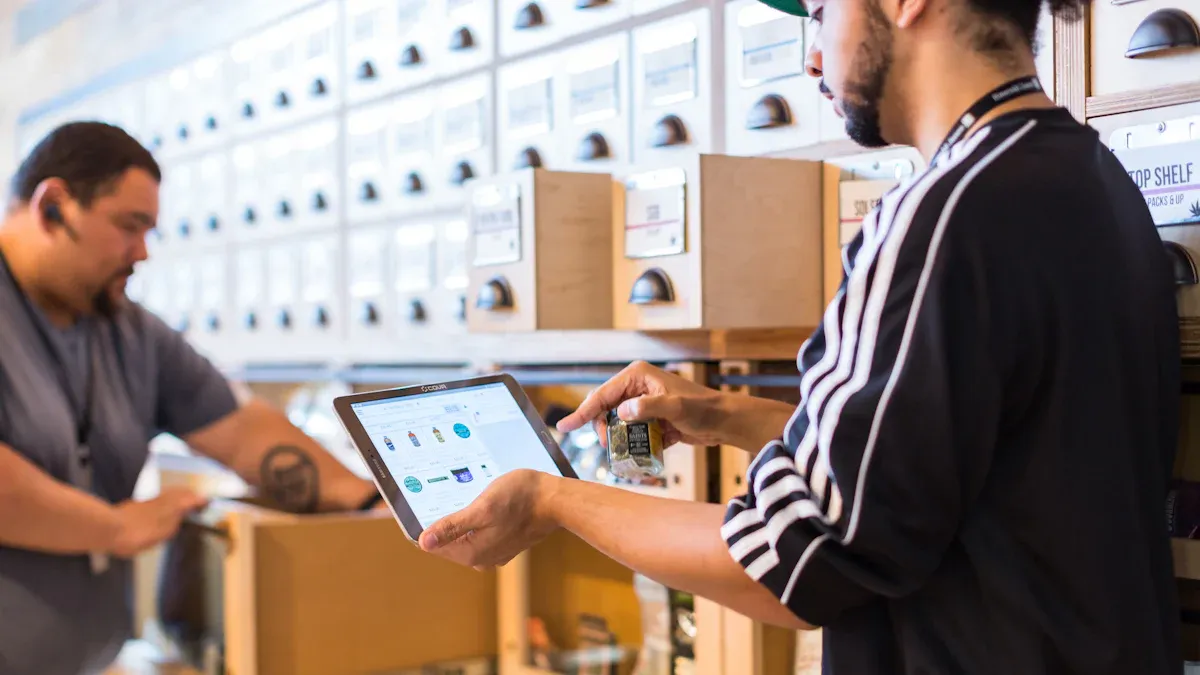Q4 Dropshipping Survival Guide for Navigating Peak Season Inventory Risks in 2025

If you want to avoid stockouts and overstock in Q4, you need to plan ahead and keep your inventory balanced. Major shopping events like Black Friday and Cyber Monday push order volumes higher than any other time of year, with Q4 alone making up over half of annual dropshipping sales.
Quarter | Sales Amount (USD) | Percentage of Annual Sales (approx.) |
|---|---|---|
Q1+Q2+Q3 combined | $37,879,688.57 | ~46% |
Q4 | ~54% |
Here’s what happens during Q4 shopping events:
Sales surge fast and high.
Customers buy more gifts and products.
You get record-breaking sales chances.
The Dropshipping Survival Guide helps you stay prepared and keep customers happy.
Key Takeaways
Make a plan for your Q4 inventory. This helps you get ready for big sales during Black Friday and Christmas. Use more than one supplier and have backup plans. This stops you from running out of stock or having delays. Use automation for tracking inventory and processing orders. This lowers mistakes and saves you time. Give customers clear updates about stock and delivery times. This helps them trust you more. Use past sales data and real-time analytics to guess how much you need to order. This helps you get the right amount. Keep your stock balanced. This stops you from having too much or too little. Find trending products early with tools like Google Trends and social media insights. After Q4, look at how you did. This helps you make your plan better for next year.
Q4 Challenges

Demand Spikes
Q4 is when many people shop for gifts and deals. This happens most during Black Friday, Cyber Monday, and before Christmas. Sales can be two to four times higher than usual. If you are not ready, you might run out of stock or lose sales.
You should watch market trends and use analytics tools. These tools help you see which products will be popular.
Many dropshippers use predictive analytics to guess demand. About 40% of eCommerce shops use these tools to plan stock.
Dynamic pricing helps you change prices when demand goes up. This helps you keep enough stock and avoid running out.
Pre-orders are good for items lots of people want. They let you take orders before you have the stock, so you do not promise too much.
Inventory management software gives real-time updates and low-stock alerts. This helps you stay ready for sudden sales jumps.
Using more than one supplier lowers your risk if one runs out.
Buffer stock agreements with suppliers give you extra stock for busy times.
Upgrading to third-party logistics (3PL) warehousing means faster local delivery and better order handling.
Tip: Work with your marketing and inventory teams. Make sure your deals match what you have in stock.
Supplier Delays
Supplier delays are a big problem in Q4. Lots of orders slow down processing and shipping. Sometimes, suppliers say they ship fast but hide real delays. Some even say they ship from local warehouses but really ship from far away.
Suppliers often do not count processing days in their shipping times.
They may only show the best times, not the usual Q4 delays.
Shipping companies get too many packages to handle.
Customs takes longer because of the holiday rush.
Bad weather or surprises can cause even more delays.
You should always check processing times with your suppliers. Ask how many orders they send on time. Give your customers extra time in your delivery dates to avoid problems.

Short Sales Windows
Q4 sales windows are short and busy. You only have a few days or weeks for big events like Black Friday and Cyber Monday. This means you must act quickly.
You need to plan early. Get your stock before the rush starts. If you wait, you might miss the best sales days. Keep your prices steady and time your deals for the best results. Have backup plans ready, like using third-party logistics or fulfilment by merchant.
Scarcity tactics work well now. Show limited stock or use countdown timers to make people hurry. Bundle products for special deals. These ideas help you stand out and sell more during the busiest shopping days.
Here’s a quick look at the most common Q4 dropshipping challenges:
Challenge | Explanation |
|---|---|
Longer Delivery Times | High sales and not enough shipping space cause delays, including customs and other problems. |
Increased Customer Service Demand | More people ask about orders and delays, so you need better support. |
Product Discounts | You give more discounts to compete, which can lower your profits. |
Stock Shortages | Suppliers might run out of stock, so you need more suppliers and good stock checks. |
Higher Marketing Costs | Advertising costs go up, especially on Facebook, making it harder to reach people. |
Q4 has lots of chances to grow, but you must be quick and smart to beat these problems.
High Customer Expectations
Q4 is a busy time with lots of shoppers. People want more than just good prices. They expect fast shipping and clear updates. They also want great service. You need to work harder to keep them happy.
Why do people expect so much in Q4? Big brands like Amazon deliver gifts very fast. Now, everyone thinks all shops can do the same. If you are slow, you might lose customers. Bad reviews can spread quickly during this season.
Here is what customers want from you in Q4:
Timely Shipping
Shoppers want their orders to come fast. They do not care about busy warehouses or slow carriers. If you say delivery will be quick, you must keep your promise.Transparency
Customers want to know when their order will arrive. They look for clear dates and honest updates. If there is a delay, you should tell them right away.Multiple Communication Channels
People check for updates in many places. Use banners on your website and notices at checkout. Send emails to keep everyone informed. This helps build trust and set fair expectations.Product Availability
No one likes to see “out of stock” during holidays. Try to keep extra stock for popular items. This way, you do not let customers down.Compensation for Delays
Sometimes, things go wrong. If a parcel is late, offer a small gift card or lower free shipping. This can make customers happy again.
You can make customers happier by offering express shipping. Many people will pay more to get gifts before a special day. Show all shipping choices at checkout. Give tracking updates so people know where their parcel is.
Tip: Get ready for Q4 by talking to your shipping partners early. Add backup carriers if you can. More choices mean fewer problems when it gets busy.
If you keep your promises and talk to customers, you will stand out. People remember shops that help them during the holidays. Meeting high expectations is hard, but it brings repeat business and good reviews.

Dropshipping Survival Guide for Q4
Q4 brings huge opportunities, but it also brings big risks. You need to watch out for both stockouts and overstock. If you do not manage your inventory well, you can lose money fast. The Dropshipping Survival Guide helps you spot these dangers and gives you tools to keep your business safe.
Stockout Risks
Stockouts happen when you run out of products. This is a common problem in Q4 because demand can spike overnight. If you do not have enough stock, you miss out on sales and upset your customers.
Lost Sales
When you run out of popular products, you lose sales right away. Customers will go to other shops if you cannot deliver. This hurts your revenue and can damage your brand. In Q4, every lost sale stings more because the sales window is short. For example, one outdoor gear retailer improved their inventory management and reduced stockouts by 85%. This led to a 30% increase in sales. You can see how much money you leave on the table if you do not plan ahead.
Customer Complaints
Stockouts do not just cost you money. They also lead to unhappy customers. People expect fast service and clear updates, especially during the holidays. If you cannot deliver, you get negative reviews and complaints. This can hurt your reputation for the whole year. Bad reviews spread quickly online, and it is hard to win back trust once you lose it.
Tip: Set up automated low stock alerts and work with more than one supplier. This helps you avoid running out of products when demand spikes.
Overstock Risks
Overstock is the other side of the problem. If you order too much, you end up with products you cannot sell. This ties up your cash and creates new headaches.
Increased Costs
Holding extra stock costs money. You pay for storage, insurance, and sometimes even loans to buy more products. During Q4, these costs can jump by 5-8% because you need more space and invest more cash. If you cannot sell everything, you may have to offer big discounts after the holidays. This cuts into your profits. Globally, stockouts and overstocks cause about $1.1 trillion in retail losses each year. You do not want to add to that number.
Storage Issues
Too much stock can fill up your storage space fast. If you use a third-party warehouse, you pay more for every extra box. Seasonal products are risky. If you do not sell them in Q4, they become dead stock. You might have to sell them at a loss or even throw them away. Chasing trends can also lead to overstock. If a product stops being popular, you are stuck with items no one wants.
Note: Inaccurate demand forecasting and chasing trends are the main reasons for overstock in dropshipping. Always check your numbers before you order more.

Why Balance Matters
You need to find the right balance between stockouts and overstock. The Dropshipping Survival Guide shows you how to do this. If you balance your inventory, you:
Avoid tying up cash in slow-moving stock.
Reduce lost sales from stockouts.
Improve your cash flow and keep your business stable.
Lower your storage and carrying costs.
Stay ready for sudden changes in demand.
Here are some ways you can keep your inventory balanced in Q4:
Use AI-driven demand forecasting to predict what will sell.
Optimise your order sizes with tools like Economic Order Quantity (EOQ).
Try Just-In-Time (JIT) inventory to cut down on storage time.
Build strong relationships with your suppliers for flexible orders.
Use inventory management software to track stock in real time.
Risk | Impact in Q4 | How to Reduce It |
|---|---|---|
Stockouts | Lost sales, unhappy customers, bad reviews | Low stock alerts, multiple suppliers, forecasting |
Overstock | High costs, dead stock, cash flow problems | Accurate forecasting, flexible orders, JIT |
The Dropshipping Survival Guide is your best friend in Q4. It helps you avoid the traps of stockouts and overstock. If you follow these tips, you can boost your profits and keep your customers happy.
Forecasting Demand
Getting demand forecasting right is very important in Q4 dropshipping. If you do it well, you will not run out of stock. You also will not have too many unsold products. Let’s see how you can use data and trends to guess what your customers want.

Historical Data
Looking at last year’s Q4 sales helps you plan better. You can find out which products sold the most. You also see when people started shopping. This lets you plan your stock and avoid surprises.
You find out which items were popular during the holidays.
You learn when sales went up and when they slowed down.
You change your stock to match what customers do.
You use analytics tools to look at lots of data and spot patterns.
Predictive algorithms help you act fast if demand changes.
Working with your marketing team means your deals match your stock, so you do not miss sales.
If you use old sales data and market trends together, you can guess which products will be popular and how much stock you need. Dropshipping and print-on-demand services help you manage stock for seasonal or special products.
Tip: Check your sales speed and profit from last year. This helps you set better prices and avoid having too much of slow-selling products.
Real-Time Analytics
You need to watch your sales as they happen. Real-time analytics tools make this simple. Platforms like Doba give you dashboards that show what is selling now. You spot trending products faster and change your stock before you run out.
Doba works with Amazon and other marketplaces, so you see new bestsellers quickly.
Sellers using Doba find trending products up to 30% faster than doing it by hand.
Automation lets you change prices and stock levels right away.
Shopify and WooCommerce show traffic and sales as they happen.
Tools like Google Analytics and Mixpanel track what customers do and how many buy.
AI and machine learning help you look at data and make better guesses.
Business Intelligence tools like Tableau and Power BI give you custom dashboards to track important numbers.
If you watch your website traffic and sales, you can react fast to sudden changes in demand. This keeps your stock balanced and your customers happy.
Market Trends
Market trends affect what people buy in Q4. You need to watch what is popular and change quickly. Seasonal styles, viral products, and social media buzz all change what you sell.
Fast trends mean you need suppliers with lots of products.
Regional warehouses help you deliver fast, which is important for holiday shoppers.
Bundling products and using gift packaging help you sell more in each order.
Automation and platform integration make order fulfilment smooth when it is busy.
Do not rely on just one seller, especially if they ship slowly.
Personalised items and clothing sell well because people feel a connection.
Scarcity marketing, like “Order by 12 December for Christmas delivery”, makes people hurry.
Get your stock before sales go up and check your numbers every day.
Trend Strategy | Why It Works |
|---|---|
Analyse Google Trends | Spot rising products before competitors |
Use social media insights | See what’s going viral and adjust listings |
Bundle products | Increase value and clear slow-moving stock |
Scarcity tactics | Encourage quick purchases |
If you stay flexible and watch trends, you can pick the right products and keep your stock moving. This is how you do well in Q4.

Supplier Management

Multiple Suppliers
You should not depend on only one supplier in Q4. If you use several suppliers, your business is safer. If one supplier runs out or is slow, you can use another. This keeps your shop open and your customers pleased.
Having more than one supplier lets you reach more markets. You can work with local suppliers in different countries. This means you can ship faster and save money for each area. You can use geo-targeting in your ads and set up shipping zones in your shop. Customers will only see products that can get to them quickly.
Here are some reasons why using many suppliers helps:
Benefit | Why It Matters in Q4 |
|---|---|
Avoid stockouts if one supplier has issues | |
Broader product range | Offer more choices to your customers |
Better supplier relationships | Negotiate better terms as your order volume grows |
Local market targeting | Faster shipping and happier customers |
Tip: Always let customers know if shipping times or packaging are different. This helps build trust and stops surprises.
Reliability Checks
Not every supplier is the same. You need to check each one before Q4 starts. Good suppliers help you keep your promises to customers.
Here is what you should check:
Product quality: Order samples and make sure they are good and safe.
Shipping reliability: Ask about delivery speed, tracking, and packaging.
Communication: Pick suppliers who answer quickly and speak your language.
Integration: Choose suppliers who connect with your eCommerce platform.
Reputation: Look for high ratings (over 4.5 stars) on review sites.
Location: Local suppliers often deliver faster when it is busy.
Payment and relationship: Pay on time and be friendly with your suppliers.
Ask questions: Learn about their company, checks, and return rules.
Test samples: Always try products before you sell them.
Note: Good suppliers help you avoid returns and bad reviews. They also make things easier when it gets busy.
Backup Plans
Even the best suppliers can have problems in Q4. You need a backup plan to keep your business safe. Set up extra suppliers for your top products. Sometimes you pay more, but it is worth it to avoid stockouts.
Here is how backup plans help you:
You have other places to get stock if your main supplier has trouble.
Local suppliers can ship faster if there is an emergency.
You avoid big risks like production stops or shipping delays.
Your shop stays open and your customers stay happy.
Keep talking to all your suppliers, especially when it is busy. Good communication gives you early warnings if something is wrong. Some sellers keep a small amount of stock with a supplier. If there is a shipping problem, you can use air freight for fast delivery. This costs more, but it saves your Q4 sales.
Pro tip: Stockouts cost more than paying a bit extra for backup suppliers. Build strong partnerships and always have a plan B.
Inventory Tools
Handling your stock in Q4 can be tough. Orders come in from everywhere. If you make mistakes, you might lose sales. You could also end up with too much stock. The right tools help a lot. Let’s see how software can keep your shop running well.
Software Integration
You need inventory software that links to your suppliers and shop. This keeps your stock numbers correct, even when sales go up. Many dropshippers use Skugrid, Easync, AutoDS, DSers, and Yaballe. These tools have smart features to help you:
Sync your stock in real time, so listings are always right.
Fill orders automatically and use backup suppliers if needed.
Set pricing rules and use AI analytics to earn more.
Connect with suppliers worldwide for faster shipping and more products.
DSers users got four times more orders from Q1 to Q4. Yaballe users made 35% more money during the holidays. Skugrid and Easync update stock every few minutes, so there are fewer cancelled orders. AutoDS and DSers send orders to other suppliers if one runs out. This saves you time and worry. You can also try Inventory Source for orders from many warehouses or Extensiv for selling on many sites.
Tip: Pick software that works well and has good support. You want your system to run even when it is very busy.
Automated Tracking
Automation is very helpful in Q4. It keeps your stock numbers right and stops you from selling too much. Here is how automated tracking helps:
Syncs your stock in real time with all your shops and suppliers.
Sends alerts when you are low on stock, so you can restock.
Updates your listings right after each sale, so you do not oversell.
Lets you use more than one supplier for each product.
Cuts down on mistakes and keeps customers happy with fast orders.
With automated tracking, you worry less about errors. Your shop always shows what is really in stock. You avoid upset customers and lost sales.
Centralised Data
Centralised data gives you control. You see all your stock in one place, even with many suppliers or shops. This makes things easier, especially in Q4.
Advantage | Explanation |
|---|---|
Centralised Dashboard for Multi-Supplier Sourcing | Manage all your suppliers in one place. No need to switch between systems. |
Real-Time Inventory Synchronisation | Keep your stock updated everywhere. Stop overselling and stockouts when it gets busy. |
Smart Stock Forecasting with Agent Support | Use old data and plans to guess what you will need. Do not waste money on slow stock. |
Local Warehouse Storage and Fast Restocking | Store bestsellers nearby and restock fast when sales rise. |
Dedicated Quality Control | Check products before sending to lower problems and keep customers happy. |
Auto-Fulfilment and Multi-Channel Management | Automate orders on all your shops. Save time and make fewer mistakes. |
When you keep your data in one place, you make better choices. You spot problems early and fix them fast. This is how you win in Q4 and get customers to return.

Safety Stock
Calculating Levels
Safety stock acts as your safety net during Q4. It helps you avoid running out of products when demand suddenly jumps or when suppliers face delays. You need to get your safety stock levels right, especially with all the ups and downs of the holiday season.
The best way to work out your safety stock for Q4 is to use the Combined Variability formula. This method looks at both how much your sales change and how often your suppliers are late. It gives you a number that covers both problems at once. Here’s a quick look at the main formulas:
Formula Name | Formula Description | When to Use | Notes |
|---|---|---|---|
Combined Variability (Formula 4) | Z × √[(σD² × LT) + (σLT² × Avg Demand²)] | When both demand and lead time vary a lot, like during Q4 holiday spikes | Handles “double uncertainty” from sales surges and shipping delays. Best for Q4 dropshipping. |
Z-Score (Demand Variability) | Z × σD × √Lead Time | When sales change a lot but supplier times stay steady | Good for demand swings, but not as strong for Q4’s double trouble. |
Average-Max Method | (Max Daily Sales × Max Lead Time) – (Avg Daily Sales × Avg Lead Time) | When you have little data or are just starting out | Simple, but not as accurate for Q4’s wild swings. |
Z is your service level factor (like 1.64 for 95% service).
σD is the standard deviation of your daily sales.
σLT is the standard deviation of your supplier’s lead time.
LT is the average lead time.
If you want to keep your customers happy and avoid lost sales, aim for a high service level. Most dropshippers use 95% or higher in Q4. You can use inventory tools like Seebiz Inventory to help with these calculations. They track your numbers and update your safety stock for you.
Tip: Don’t guess your safety stock. Use real sales and delivery data from past Q4s. This makes your numbers much more accurate.
Dynamic Adjustments
Q4 never stays the same for long. You need to check your safety stock often and change it when things shift. If you only look at your numbers once a year, you might get caught out by a sudden rush or a supplier problem.
Here’s how often you should review your safety stock in Q4:
Check at least once every quarter, or when you see big changes in sales or supply.
For products that sell fast or cost a lot, check every month or even every week.
If your supplier starts missing deadlines or shipping gets slow, review your safety stock right away.
During Q4, with all the sales and promotions, you should adjust your safety stock more often than usual—think monthly or weekly.
You can set up alerts in your inventory software to remind you when it’s time to review. If you spot a trend, like a product suddenly selling out, act fast. Add more safety stock for that item. If something slows down, lower your safety stock to save money.
Note: Keeping enough safety stock means you can handle surprise demand spikes. You won’t lose sales, and your customers will trust you to deliver, even when things get busy.
Market Monitoring

Trending Products
Spotting trending products early gives you a big advantage in Q4. You want to know what shoppers will want before everyone else does. Google Trends is a great tool for this. It shows you what people are searching for and when those searches spike. Here’s how you can use it to stay ahead:
Monitor seasonal spikes: Look at 2-5 years of search data. You’ll see which products get popular before holidays or certain seasons. This helps you prepare your stock and marketing.
Compare year-over-year interest: Check if a product’s popularity is rising or falling. Focus on items that are trending upwards for Q4.
Spot event-driven surges: Notice when searches jump around events like Black Friday. You can time your promotions and launches to match.
Use geographic data: See which regions have the most searches. Target your ads and stock to those areas for better results.
Plan ahead: Start your inventory and marketing campaigns 4-8 weeks before you expect demand to rise. This gives you time to get stock and set up ads.
Mix seasonal and evergreen products: Keep your cash flow steady by selling items that do well all year, alongside your Q4 bestsellers.
Track trends regularly: Set alerts and check trends often. Adjust your product range to match what’s hot. This keeps your business flexible and ready for anything.
Google Trends gives you early warnings about what’s coming. You can see where and when demand will rise, so you never get caught out by sudden spikes.
Social media is another goldmine for trend spotting. Watch TikTok, Instagram, and Facebook to see what’s going viral. If you notice a product getting lots of attention, you can move fast to add it to your shop.
Rapid Response
Q4 moves quickly. You need to react fast when trends change or when a product suddenly takes off. Here are some ways to stay on top:
Promote early and often: Start your marketing before Q4 kicks off. Use social media, paid ads, influencers, and emails to build excitement.
Watch your sales and stock: Use tools to track what’s selling and how much you have left. Set reorder points so you never run out.
Be ready to pivot: If something isn’t selling, try a new product or change your ads. Don’t wait—move quickly to catch new trends.
Optimise your listings: Use clear titles, great photos, and seasonal themes. Make your products stand out for Q4 shoppers.
Source smart: Order high-demand products early, even in late summer. This helps you avoid delays and shortages.
Stay in touch with suppliers: Confirm lead times and shipping details. Good communication stops nasty surprises.
Test samples first: Check quality and create marketing content before you order in bulk.
Tip: The faster you spot a trend and act, the more sales you’ll make. Keep your sourcing and marketing flexible, and you’ll always be ready for whatever Q4 throws at you.
Market monitoring is your secret weapon. By tracking trends and responding quickly, you can keep your shop stocked with what customers want—right when they want it.
Automation & Efficiency

Order Processing
You want your orders to go out quickly in Q4. Sales go up a lot, so you need to keep up. Using automation is the best way to do this. Software can do jobs like placing orders and updating tracking. It also changes prices and stock for you. This means you do not have to do these jobs by hand. You make fewer mistakes and save money.
CJ Dropshipping USA uses automation right after a customer buys. Their system updates stock straight away. You will not sell things you do not have. This means fewer cancelled orders and happier shoppers. Automation lets you grow your shop. You can handle lots of orders without getting stressed.
Here is how automation and manual work compare:
Benefit Category | Manual Order Processing | Automated Order Processing | Impact on Q4 Dropshipping Efficiency |
|---|---|---|---|
Labour Cost | High because you do the work yourself | Low as software does most jobs | Saves time and stops burnout when Q4 is busy |
Human Error | Mistakes happen often and cause problems | Hardly any mistakes with automation | Stops refunds and cancellations during busy times |
Time Spent Per Order | Takes 5–10 minutes for each order | Takes less than 1 minute per order | Gives you more time for other jobs and helping customers |
Customer Support Load | You must update and reply to customers | Updates and messages are sent automatically | Makes your job easier and keeps customers happy |
Pricing & Stock Updates | You must check and change these yourself | Software updates prices and stock right away | Stops you selling out-of-stock or at wrong prices in Q4 |
Overall Efficiency | Hard work and easy to make mistakes | Simple and easy to manage | Lets you handle lots of Q4 orders without trouble |
Tip: Automation lets you spend more time growing your shop and helping customers, not just doing orders.

Product Bundling
Bundling products is a clever way to use your stock in Q4. You can put slow-selling items with popular ones. Sell them together for a special price. This makes bundles look like a good deal. Shoppers like getting more for less. Bath & Body Works does this by making gift sets with their top scents. These are great for holiday gifts.
Selling bundles helps you get rid of extra stock. Your warehouse stays neat and tidy. You also save money on shipping and storage. This is good if you use third-party logistics. Bundles make it easier for shoppers to pick gifts. They also help you sell more.
Bundles make gift shopping simple and give discounts, which people like at Christmas.
You sell more at once, so your average order value goes up.
Warehouse workers can pack and send bundles faster, so orders arrive quickly.
You can upsell and get customers to buy again.
Bundling helps you clear slow stock, makes customers happy, and keeps your business running well.
Supplier Communication
Talking well with your suppliers keeps things running smoothly in Q4. Set up automatic updates for stock and orders. This way, you always know what is in stock and when new items will come. Automated messages help you spot problems early and fix them fast.
You can use software to tell suppliers when you need more stock. If you sell bundles, let suppliers know so they can get items ready together. Quick and clear messages mean fewer mistakes and faster orders.
Keep in touch with your suppliers. Automation helps you share news fast, so you do not miss anything in the busy season.

Customer Communication
Stock Updates
You need to keep your customers in the loop about what is in stock, especially during Q4. People want to know if their favourite items are available before they buy. If you give regular updates, you build trust and avoid disappointment.
Here are some ways you can keep customers informed:
Show real-time stock levels on your website. Use banners or pop-ups to highlight low stock or restocks.
Send email alerts when popular products are almost gone or back in stock.
Use cloud-based inventory systems. These tools update your website and emails automatically, so customers always see the latest information.
Organise your stockroom and count items carefully. This helps you avoid mistakes and keeps your updates accurate.
Use barcode scanners and automatic tracking. These tools make sure your stock numbers are right.
Set up regular checks for your most important products. This way, you can spot problems early and fix them fast.
Tip: If you keep your stock data up to date, you will have fewer cancelled orders and happier customers.
Managing Delays
Delays can happen in Q4. Shipping gets busy, and suppliers might run late. You need to talk to your customers as soon as you know about a delay. This helps manage their expectations and keeps them calm.
Let customers know about possible delays before they order. Use clear messages at checkout or in product descriptions.
If a delay happens, send an email right away. Tell them how long the wait might be and what you are doing to help.
Offer a similar product or a free upgrade if their item is out of stock. This shows you care and want to make things right.
Keep your customer service team ready to answer questions. Train them to be friendly and helpful.
Stay in touch with your suppliers. If you know about a problem early, you can warn your customers sooner.
Customers appreciate honesty and quick updates. If you keep them informed, they are more likely to stay loyal.
Transparency
Being open with your customers is key during Q4. People want to know what is happening with their orders. If you are honest about challenges, you build trust that lasts beyond the busy season.
Share updates about stock and shipping on your website and in emails.
Explain why delays might happen, like busy warehouses or bad weather.
Tell customers what you are doing to solve problems, such as using backup suppliers or offering express shipping.
Use simple language. Avoid making excuses. Just tell the truth.
If you make a mistake, admit it and offer a solution, like a discount or a gift card.
When you are transparent, customers feel respected. They remember your honesty and are more likely to shop with you again.

Q4 Checklist
Preparation
Getting ready for Q4 is all about planning ahead. You want to make sure you have everything in place before the rush begins. Here’s a step-by-step checklist to help you prepare:
Plan for all the big Q4 sales events. Think about Halloween, Black Friday, Cyber Monday, Christmas, and even after-Christmas sales. These dates drive most of your sales.
Review your marketing budget. Costs go up in Q4, so set aside extra money for ads and promotions.
Pick products that fit the season. Choose items that people want for gifts or holiday celebrations.
Create product bundles. Offer discounts when customers buy more than one item. This helps you sell slow-moving stock and increases your average order value.
Set up email marketing. Remind shoppers about their abandoned carts and send out special offers.
Use SMS marketing to reach warm leads. Quick messages can boost your return on ad spend.
Check if your suppliers offer special Q4 discounts. Selling these products can help you earn more.
Hire a virtual assistant for customer service. You’ll get more questions during Q4, so extra help keeps your service strong.
Tip: Build a good relationship with your suppliers now. Make sure you can talk to them easily and that your systems work together.
Monitoring
Once Q4 starts, you need to keep a close eye on your business. Stay alert and act fast when things change. Here’s what to watch:
Track your inventory levels every day. Use inventory management tools to see what’s selling and what’s running low.
Set minimum stock thresholds. When you get close to running out, your store should mark items as out of stock before your supplier does.
Watch your supplier’s stock and delivery times. If you spot delays, update your customers right away.
Keep an emergency plan ready. If demand spikes or a supplier has problems, you need to act quickly.
Monitor your marketing campaigns. Adjust your ads and emails based on what’s working.
Stay flexible. The Dropshipping Survival Guide reminds you that Q4 can change fast, so you need to adapt quickly.
Review
After Q4 ends, take time to look back and learn. This helps you do even better next year.
Review your sales data. See which products sold best and which ones didn’t move.
Check your inventory records. Did you have too many stockouts or too much leftover stock?
Ask your team and customers for feedback. Find out what worked and what needs fixing.
Update your supplier list. Keep the good ones and look for new partners if needed.
Plan for next year. Use what you learned to make your next Q4 even smoother.
Note: Reviewing your Q4 performance helps you spot trends and avoid the same mistakes in the future.

Best Practices
Key Strategies
You want your dropshipping shop to work well in Q4. The best way is to use smart steps that stop stockouts and overstock. Here are some easy tips you can follow:
Forecast demand using real data
Check last year’s sales and look at trends now. This helps you order the right amount of stock.Work with multiple suppliers
If one supplier runs out, you have others ready. This keeps your shop open and customers happy.Automate your inventory tracking
Use software that updates your stock numbers all the time. You spot problems early and fix them fast.Keep safety stock for popular items
Hold extra stock for products that sell quickly. This helps you handle sudden spikes in demand.Bundle slow-moving products
Make gift sets or special deals. You clear out old stock and sell more at once.Communicate clearly with customers
Give regular updates about stock and shipping. Honest messages build trust and keep shoppers loyal.Review your performance after Q4
Check what worked and what did not. Use these lessons to do better next year.
Tip: The Dropshipping Survival Guide says to check your stock and suppliers every week in Q4. This helps you spot problems before they get big.
Common Pitfalls
Many dropshippers make the same mistakes in Q4. If you know what to look for, you can avoid trouble and keep your shop strong. Here are the most common problems:
Long delivery times upset customers. High order numbers slow down shipping and customs. You can avoid this by picking suppliers who handle lots of orders and by giving clear delivery updates.
Customer service demands go up. People ask more questions when orders are late. Keep your replies friendly and helpful to build loyalty.
Stock shortages happen when suppliers run out. Use stock tools and work with more suppliers to stop listing items you cannot deliver.
Marketing costs rise as ads get more expensive. Optimise your campaigns and focus on products that sell well to keep costs down.
Shipping rates confuse shoppers. High or tricky fees can stop people from buying. Use flat or simple rates to make costs easy.
Relying on one supplier is risky. Use more suppliers and test them before Q4 starts.
Expecting products to sell without marketing leads to poor results. Promote your items and offer discounts that fit the season.
Not matching your products to Q4 events means you miss sales. Target holidays like Halloween, Black Friday, and Christmas with the right products.
Pitfall | How to Avoid It |
|---|---|
Long delivery times | Pick reliable suppliers, give clear updates |
Stock shortages | Use more suppliers, watch stock closely |
High marketing costs | Optimise ads, focus on bestsellers |
Complex shipping rates | Offer flat or simple shipping |
Relying on one supplier | Use more and test suppliers |
Poor product alignment | Sell seasonal products for Q4 events |
Remember, if you stay alert and use these best practices, you can make Q4 your best season yet.
You now have the tools to balance your inventory and avoid costly mistakes this Q4. Use the Dropshipping Survival Guide to plan ahead, work closely with your suppliers, and keep your customers updated. Check your checklist often and follow the best practices for a smooth season. Ready to take on Q4? Share your own tips or ask questions in the comments below!

FAQ
How can I stop running out of stock during Q4?
You should check your inventory every day. Use software that gives you real-time updates. Set alerts for low stock. Work with more than one supplier. This way, you can restock quickly if you sell out.
What is the best way to avoid overstock after the holidays?
Order smaller amounts more often. Bundle slow-moving products with bestsellers. Watch your sales data closely. If something is not selling, lower the price or run a special offer to clear it out.
How do I handle supplier delays in the busy season?
Always ask your suppliers about their Q4 plans. Keep backup suppliers ready. Tell your customers about possible delays before they order. If a delay happens, send updates right away and offer a small gift or discount.
Should I use safety stock for all my products?
You should keep safety stock for your most popular items. For slow sellers, order only what you need. Check your sales trends to decide which products need extra stock.
How can I keep customers happy if an item is out of stock?
Let customers know as soon as possible. Offer a similar product or a free upgrade. Give a discount or a gift card if they wait. Honest updates help build trust and keep shoppers coming back.
What tools help with Q4 inventory management?
Inventory management software like DSers, AutoDS, or Skugrid works well. These tools track your stock, send alerts, and update your listings. They also help you work with more than one supplier.
How do I spot trending products before Q4 starts?
Check Google Trends and social media. Watch what people talk about and share. Look at last year’s bestsellers. Start planning your stock 4–8 weeks before Q4 for the best results.
Is it worth automating order processing for Q4?
Yes, automation saves you time and stops mistakes. Orders go out faster. You can handle more sales without extra stress. Customers get their orders quickly, which means better reviews and more repeat business.

TangBuy: A Smarter Way to Dropship in 2025
If you're looking to stay competitive with dropshipping in 2025, speed and trend-awareness are key. TangBuy helps you stay ahead with real-time product trends, fast fulfilment, and factory-direct sourcing. With over 1 million ready-to-ship items, 24-hour order processing, and seamless Shopify integration, TangBuy makes it easier to test, scale, and succeed in today's fast-moving eCommerce landscape.
See Also
Profitable Dropshipping Concepts To Explore In 2025
Complete Guide To Starting A Dropshipping Venture In 2025
Essential Advice For eBay Dropshipping Sellers To Succeed 2025

